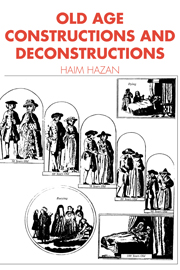Book contents
- Frontmatter
- Contents
- Acknowledgements
- Introduction: towards knowledge of old age
- PART I REPRESENTATIONS OF AGEING: LANGUAGES ABOUT OLD AGE
- 1 The social trap: the language of separation
- 2 The cultural trap: the language of images
- 3 The personal trap: the language of self-presentation
- 4 The theoretical trap: the missing language
- PART II PRESENTATIONS OF AGEING: LANGUAGES OF THE OLD
- Conclusions: the nature of knowledge about ageing
- Notes
- Bibliography
- Index
3 - The personal trap: the language of self-presentation
Published online by Cambridge University Press: 05 June 2012
- Frontmatter
- Contents
- Acknowledgements
- Introduction: towards knowledge of old age
- PART I REPRESENTATIONS OF AGEING: LANGUAGES ABOUT OLD AGE
- 1 The social trap: the language of separation
- 2 The cultural trap: the language of images
- 3 The personal trap: the language of self-presentation
- 4 The theoretical trap: the missing language
- PART II PRESENTATIONS OF AGEING: LANGUAGES OF THE OLD
- Conclusions: the nature of knowledge about ageing
- Notes
- Bibliography
- Index
Summary
If we accept that aged people are surrounded by a society that assigns them false images and that they are therefore trapped in a labyrinth of distorting mirrors, then the question arises of what self-conception they can possibly project. According to the concept of the ‘looking glass self’ (Mead 1934; Cooley 1972) we see ourselves as we imagine others see us, and therefore the behaviour of older people and their attitudes towards themselves are shaped and reinforced by society's prevailing images of them. By adopting these images, the elderly in turn confirm and strengthen them.
Old people, for example, are thought to dress in drab, uniform clothing appropriate to the dull world in which they are considered to live. Many elderly people, upon accepting the label of ‘aged’, do indeed change their style of dress. Those who are reluctant to alter their appearance or prefer the fashionable arouse derision or surprise. A more extreme example is the physical limitations which older people adopt once they accept their definition as aged. Some may begin to stoop and shuffle, others may develop hearing deficiencies that have no apparent physiological basis (a kind of ‘social deafness’ that develops when people consciously or unconsciously choose not to hear). Some complain of deteriorating vision, others adopt movements characteristic of the physically handicapped in the absence of any such serious limitations (Esberger 1978; Levy 1979).
- Type
- Chapter
- Information
- Old AgeConstructions and Deconstructions, pp. 33 - 38Publisher: Cambridge University PressPrint publication year: 1994
- 1
- Cited by

